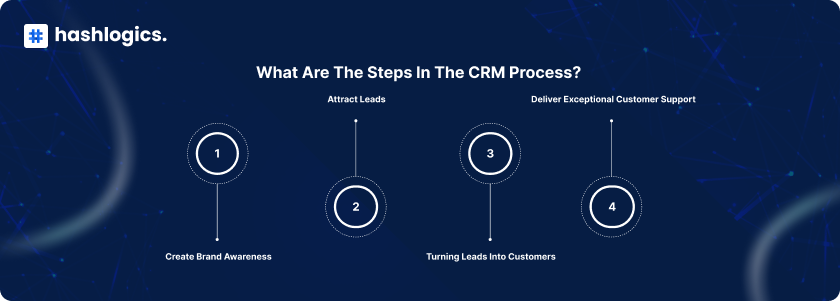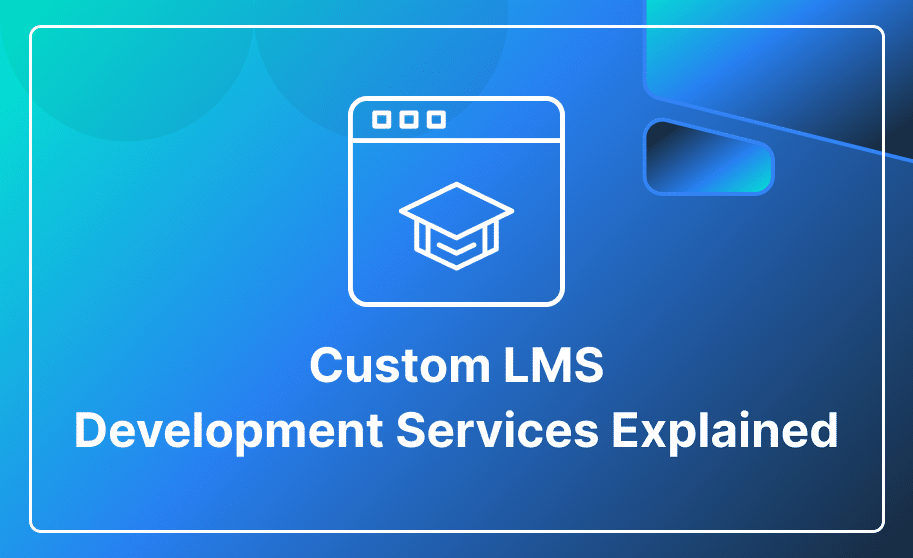Today, consumers expect a personalized customer experience tailored to their unique preferences. To fulfill their demands, it is essential to understand your customer’s needs and wants, allowing you to adapt and excel in delivering what they want.
What is the CRM Process?
The CRM process is a strategic approach to ensure that every customer interaction remains personalized and significant. It consists of five steps.
A Customer Management System (CRM) gives your team the essential data and functionalities required to effectively implement this strategy, ultimately converting leads into loyal customers.
An Overview of the CRM Process Cycle
To understand the steps of the CRM process, you need to know about the customer lifecycle. It is the first step that sales representatives learn to understand how an individual turns into a loyal customer.
The CRM cycle consists of five important stages:
- Reaching Potential Customers
- Lead Acquisition
- Customer Conversion
- Retention
- Customer Loyalty
The CRM process involves concrete actions that organizations must take to guide consumers through learning about their brand and eventually becoming loyal, returning customers.

What are the steps in the CRM Process?
The Customer Relationship Management Process involves five steps that require the active involvement of marketing, sales, and support departments. To better understand these steps, we will explore the practical implementation of each step.
- Create Brand Awareness:
The first step is to attract new customers and introduce them to your business. This responsibility is usually handled by the marketing team, which uses various strategies to accomplish, such as:
- Understanding the Target Audience. Marketers will research to find out who their audiences are, their interests, chosen communication channels, the messages that resonate with them the most, and their key concerns.
- Divide your target audience into segments. Marketers create audience personas to group the brand’s target audience based on similar interests or demographics. It helps marketers recognize the individuals who are most likely to become customers and who should be the focus of their campaigns.
- Creating Marketing Campaigns that resonate with specific target demographics involves A/B tests and marketing automation to figure out what is effective and what isn’t. It helps to create tailored campaigns for unique customer segments, be it on social media or email, and in developing strategies for potential leads.
When it comes to completing these steps, a CRM solution is a valuable source of information. The tool can reveal patterns in previous leads and customers, providing marketing teams with a comprehensive view of their target audience. Moreover, beyond grasping demographic similarities, marketers can also analyze sale notes within their CRM technology to comprehend what led to past conversions. By understanding your leads, marketers are better prepared to craft successful campaigns.
- Attract Leads:
When you start your CRM planning by introducing your brand to the potential customer, that is just the start of the CRM process. Subsequently, the goal is to inspire them to explore further and engage with your business.
Depending on your company’s structure, acquiring leads can be the responsibility of marketing or sales teams. For instance, your marketing team might encourage website visitors to provide their emails through a newsletter signup CTA or a social media giveaway. On the other side, the Sales team could utilize their CRM system to establish live chat on your website. With this feature, your team can actively engage with potential customers who visit your website.
- Turning Leads into Customers:
You’ve effectively connected with your leads, and they’re interested. The third step in the CRM process is to convert those leads into loyal customers.
To achieve this, sales representatives must assess the level of interest in leads, specifically whether they are inclined to make a purchase. A CRM system plays a crucial role in this regard. The historical data from previous successful sales can be used to establish lead-qualifying criteria. These criteria can be incorporated as “attributes” within your CRM’s lead-scoring tool, helping representatives recognize opportunities with the highest likelihood of resulting in a sale.
If the leads are likely to make a purchase, representatives must be able to nurture them and build the trust necessary for conversion. Representatives can do this by providing the leads with case studies, white papers, and other resources that can influence their decision-making.
- Deliver Exceptional Customer Support:
You’ve effectively turned your lead into a customer, which is fantastic! However, the CRM process doesn’t conclude when a customer converts. For the growth of a company, it’s essential to retain customers.
How can you ensure they keep coming back?
You can ensure this by providing exceptional customer support.
Nearly forty-nine percent of customers believe that the most crucial element of good customer support is solving their problems quickly. With CRM tools, support agents can easily find the customer’s past information, which helps them to solve issues faster.
Fifty-seven percent of customers expect to have options for reaching out to customer support through multiple channels. CRM features empower support agents to offer support across various channels and also to oversee these conversions in a single, unified view.
With the appropriate CRM system, your support agents have the necessary customer information and resources required to resolve customer’s issues swiftly. It facilitates a smooth and efficient experience for both the customer and the support agent.
- Boost Upsells
When we think about customers who come back, we usually imagine people who consistently return to purchase the products they like or are familiar with. But there is another vital thing that existing customers provide value- by deciding to buy more expensive products.

How Can You Persuade Your Customers to Switch products?
You can begin this by sending personalized recommendations through email. You can also use CRM to group customers into lists based on their similar purchase histories. Afterward, you can design customized email templates that send relevant new product information to entire lists of customers at once. It ensures that the promotional offers or new releases you send reach the people who are most likely to purchase them.
If your business is service-based, you can identify upselling chances by making check-in calls. Use your CRM to schedule reminders for reaching out to repeat customers regularly. Ask them about their satisfaction and if there is any way you can enhance your service. Their needs might have changed since your last interaction, and they could be open to an upsell.
Enhance Customer Experience with CRM Process
The five-step CRM strategy is designed to provide an exceptional experience at every stage of the customer’s journey. With all the necessary customer data within your reach, a CRM tool enables seamless execution of this process.
If you’re interested in CRM services, feel free to contact us at Hashlogics, and we’ll be happy to assist you in implementing these strategies for your business.














